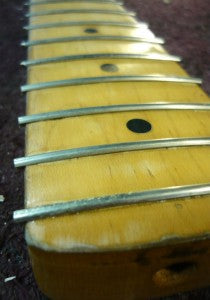Greco P bass re-fret
Share
This is one of those old Japanese brands that still surprise me to this day, in a good, no, a great way. The history of Greco is well known and out there if you don't know so I won't go into details. Suffice to say, they made (and make) GREAT stuff. In some cases better than the product they were copying. I've played Grecos I'd take over the original, and this is one of 'em.
This came in for a re-fret as it's a 1977 bass that's been PLAYED ......... LOTS. The frets were very worn in places over the neck and the E strings had some dead spots that weren't coming out with a dress as I had nothing left to work with.
Being a maple fretboard the trick here is to get the old frets out without damaging the paint, which is applied after the frets are installed so there are little mounds of paint running up each side the frets. If you just "pull" the frets out the paint will chip in big chunks. The idea is to run a razor blade down each side of the fret before heating up and removing. This scores the paint and (hopefully)stops it from chipping.
With the frets out nicely it was time to level the board a bit. Obviously if you're trying to keep the original finish intact you can't go too crazy here but at the same time, there's no point in doing this if the fretboard is all over the place. This one was pretty damn good and only needed a medium sand.
There was a small hump around the 12th fret but nothing that couldn't be taken out without getting through the (thick) finish.
I pressed these frets in as I do with most bolt on necks as I have access all the way up the neck and have good even pressure for all the frets. These had fairly wide fret slots so I used a little glue to anchor the fret tangs in for piece of mind.
These were medium large bass style frets and will feel quite different compared to what was in the neck originally as they had got SO low. Once the owner plays it for a while it will feel "right" and become normal.
With the frets in and no need for a re-finish I polished up the fretboard and frets while keeping the "worn" look and feel. This is my preferred method as it still matches the rest of the bass AND "feels" more ........ familiar.
With the new frets leveled, crowned and polished it was time for a new nut as the new frets are MUCH higher than the old ones.
A bone blank is cut to size and marked out ready for slotting. I rounded the edges of the new frets more than usual to give them a "played in" feel as the neck had quite a roll on the edges. If you leave the fret ends "new"on these necks they feel sharp as if you haven't finished the job properly. Rolling those ends just slightly makes them feel like they've been played, like the neck.
When doing major work on peoples well loved guitars like this I'm always conscious of how it's going to feel when they get it back. I always tell players that a re-fret WILL change the way a guitar feels, and sometimes sound so expect that the guitar you've been playing for years to NOT be the same guitar. Having said that, when a guitar gets to the point of unplayable because of low frets, it's time to re-fret.
Time to go back home and get played for another 35 years.






















